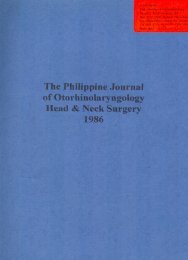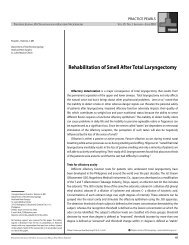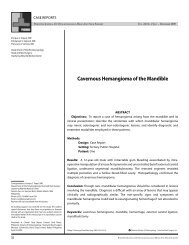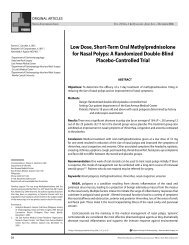You also want an ePaper? Increase the reach of your titles
YUMPU automatically turns print PDFs into web optimized ePapers that Google loves.
With regard to microbiology of nasal packing ma- with saliva particularly to account for the varied flora<br />
terials (see Table 7), the most number of isolates were recovered from the inner dressing of the finger-cot,<br />
from the inner dressing of the finger-cot. This was Contamination on collection could not be also disexpected<br />
because it was not lubricated intentionally counted since all packing materials passed through both<br />
with an antibiotic ointment. Colonization was not con- nares. In general, the presence of microbial growth<br />
sidereal clinically significant since it was confined within remained academic since all patients did not clinically<br />
the finger-cot. Nonetheless, the outer surface of the manifest signs of active infection.<br />
finger-cot revealed statistically more isolates regardless<br />
of kind than the medium-strip (sign, 19=0.04). This may<br />
be due to the fact that the finger-cot is made of latex CONCLUSION<br />
which is a non-absorbent and non-porous material,<br />
making the antibiotic ointment easily washed away by This study hasestablished thatthe finger-cotmethod<br />
the excessive rhinorrhea associated with nasal packing, of nasal packing is equally effective as the standard<br />
_iStaphylococcus albus was the most common microor- medium-strip in controlling post-operative bleeding. In<br />
ganism cultured from all packing materials. Since it is addition, it offers the following advantages over the<br />
non-pathogenic in healthy adults, its exclusion from sta- medium-strip method namely: (1) significant lesser<br />
tistical testing will bring about no significant difference pain on insertion and on removal of the pack, (2) aignibetween<br />
the outer surface of the finger-cot and the ficant lesser recurrence of bleeding after removal with<br />
mediumstrip gauze in terms of potential pathogenic a generally smooth nasal mucosa, (3) relatively costmicrobes<br />
recovered (sign test, p= 1.0; see Appendix C). effective since little amount of antibiotic ointment is<br />
In normal nasal flora as studied by Slavin et al, Staphy- needed (the surgical gloves may come from those to be<br />
lococcus epidermidis (albus) was present in 83%, S. discarded), and (4) early removal i.e., on the third post-<br />
Aureus in 23 %, Streptococcus viridans in 17%, and operative day or even earlier. Although it requires extra<br />
Enterobacter species in 4% (percentages total over time for proper insertion, this shortcoming can be over-<br />
100% due to mixed growths). All patients in this study, come by familiarity with the method. Microbial isolates<br />
however, had chronic sinusitis which might also add to from all nasal packing, though more from the finger-cot,<br />
the emergence of gram-negative bacteria. Another were not clinically significant as a whole.<br />
contributory source was the possible contamination<br />
TABLE<br />
1 : TYPES OF NASAL SURGERY<br />
1. Polypectomy, ethmoidectomy, antrostomy-bilateral<br />
withorwithout partialmiddle<br />
turbinectomy-bilateral ...........................................................................................................................................<br />
13<br />
2. Ethmoidectomy, antrostomy-bilateral<br />
withorwithout partialmiddle<br />
turbinectomy-bilateral ............................................................................................................................................<br />
7<br />
3. Polypectomy, ethmoidectomy, antrostomy/<br />
ethmoidectomy, antrostomy<br />
withorwithout partialmiddle<br />
turbinectomy-bilateral ............................................................................................................................................<br />
6<br />
4. Submucous resection-septurn<br />
polypectomy, ethmoidectomy, antrostomy-bilateral<br />
withorwithout partialmiddle<br />
turbinectomy-bilateral ............................................................................................................................................<br />
5<br />
5. Submucous resection-septum<br />
Ethmoidectomy, antrostomy-bilateral .....................................................................................................................<br />
1<br />
TOTAL .................................................................................................................................. 32....................<br />
90<br />
t
















